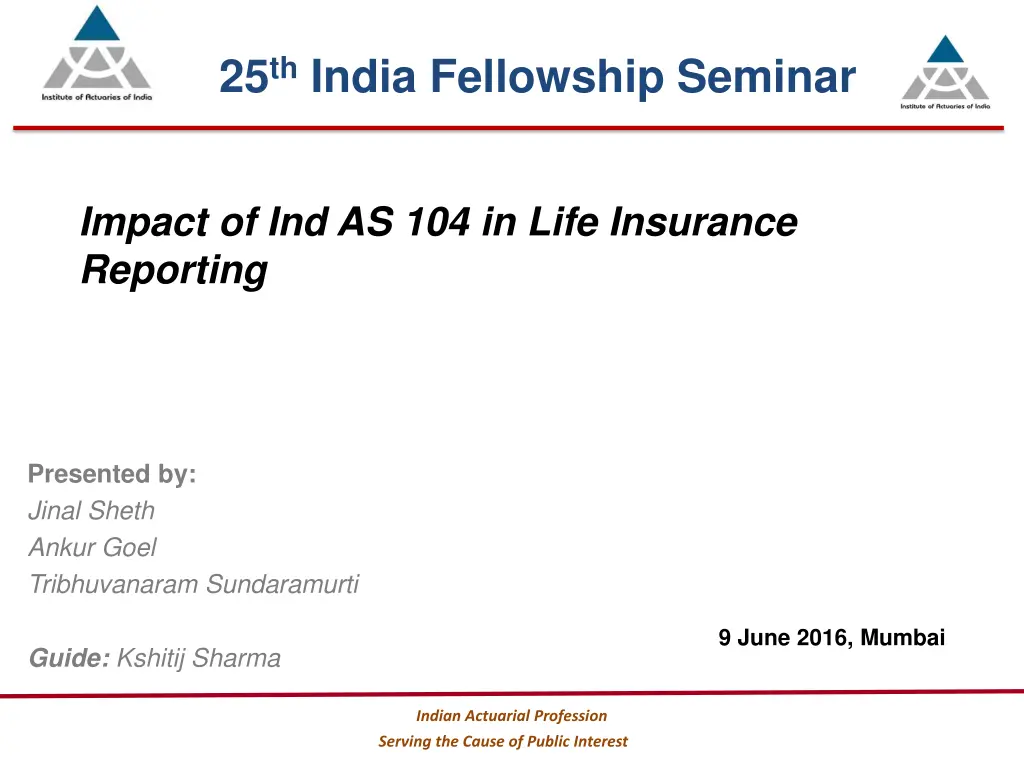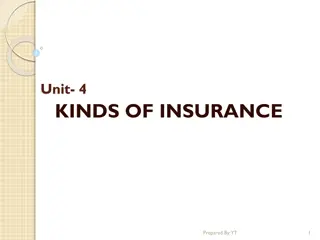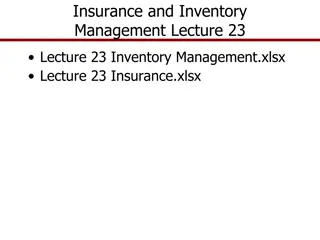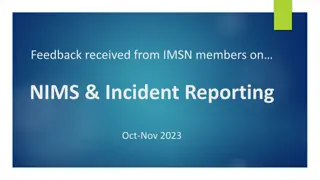
Impact of Ind AS 104 on Life Insurance Reporting
Explore the implications of Ind AS 104 on life insurance reporting, covering topics such as contract classification, unbundling, embedded derivatives, liability adequacy testing, and more. Gain insights into how this accounting standard affects financial statements and disclosures for life insurers in India.
Download Presentation

Please find below an Image/Link to download the presentation.
The content on the website is provided AS IS for your information and personal use only. It may not be sold, licensed, or shared on other websites without obtaining consent from the author. If you encounter any issues during the download, it is possible that the publisher has removed the file from their server.
You are allowed to download the files provided on this website for personal or commercial use, subject to the condition that they are used lawfully. All files are the property of their respective owners.
The content on the website is provided AS IS for your information and personal use only. It may not be sold, licensed, or shared on other websites without obtaining consent from the author.
E N D
Presentation Transcript
25th India Fellowship Seminar Impact of Ind AS 104 in Life Insurance Reporting Presented by: Jinal Sheth Ankur Goel Tribhuvanaram Sundaramurti 9 June 2016, Mumbai Guide: Kshitij Sharma Indian Actuarial Profession Serving the Cause of Public Interest
Agenda Objective and Scope of Ind AS 104 Contract Classification & Unbundling Embedded Derivatives Recognition & Measurement Liability Adequacy Testing (LAT) Disclosures General Impact on Life Insurers Impact on Reporting for Life Insurers Financial Statements Disclosures Timelines Key Issues that Need Clarification www.actuariesindia.org 2
Objective and Scope of Ind AS 104 Objective To specify the financial reporting for insurance contractsby any entity that issues contracts. Scope An entity shall apply this Indian Accounting Standard to:- Insurance contracts (including reinsurance contracts) that it issues and reinsurance contracts that it holds. Financial instruments that it issues with a discretionary participation feature. www.actuariesindia.org
Insurance Contract - Definition Ind AS 104 requires the contracts to be classified as Insurance or Investment contract. The risk transferred in the contract must be insurance risk (risk except for financial risk). www.actuariesindia.org 4
Unbundling of Contracts Some insurance contracts contain both insurance components. Unbundling required if both the following conditions are met: and deposit is If unbundled, Apply this Standard to the insurance component. Apply Ind AS 39 to the deposit component. Insurer can measure the deposit component separately Insurer s accounting policies do not otherwise require it to recognise all obligations and rights arising from the deposit component. www.actuariesindia.org 5
Embedded Derivatives Ind AS 39 requires an entity to separate embedded derivatives from the host instrument that contains them, measure them at fair value and recognise changes in their fair value in profit or loss. However, an insurer need not separate an embedded derivative that itself meets the definition of an insurance contract. Type of Embedded Derivative Treatment if embedded in a host insurance contract Treatment if embedded in a host investment contract Death benefit linked to equity prices or equity index, payable only on death or annuitisation Fair value measurement is not required Not applicable Death benefit that is the greater of: unit value of an investment fund and guaranteed minimum Fair value measurement is not required Not applicable www.actuariesindia.org 6
DiscretionaryParticipation Features In FinancialInstruments In Insurance Contracts = Guaranteed Element + Discretionary Participation Feature Liability: If entire discretionary participation feature classified as liability Apply Liability Adequacy Test Liability:Need not to recognise it separately. It can be classified as Total Liability (However it can be classified as guaranteed element and equity component) separate equity component Apply Ind As 39. ( Include Intrinsic Value Option) If part/all of feature classified as of Premium: Recognise all premiums revenue and recognise the resulting increase in carrying amount of liability as Premium: Recognise all premiums as Revenue without separating any portion that relates to equity component as an expense www.actuariesindia.org 7
Recognition & Measurement Existing Contracts Provisions only for existing contracts Liability Adequacy Test To determine adequacy of insurance provisions Reinsurance Asset Impairment testing of reinsurance asset Liabilities are shown directly, and not offset against reinsurance asset No Offsetting www.actuariesindia.org 8
LiabilityAdequacy Testing When To Assess What to Assess How to Assess At the end of each Reporting period Whether recognised insurance liabilities are adequate Using current estimates of all contractual cash- flows & related cash-flows ( claims handling costs, embedded options & guarantees If the test shows that the liability is inadequate, the entire deficiency must be recognised in profit or loss The liability measurement principles are pretty stringent in India as negative reserves are not considered and flooring of reserves to the surrender value in the valuation of policy liabilities www.actuariesindia.org 9
Impact on Life Insurers Key implications of segregation of insurance and investment contracts (considered in the next section) Changes in Financial Statements Significant Effort on Disclosures Most material impact of Ind AS 104 is on disclosures which will require heavy investment of resources in the initial years of implementation www.actuariesindia.org 10
Key Implications of Un-bundling Changes in IT systems to capture the deposit component and recognise front end fees as revenue Erosion of top-line with deposit component accounted as deposit liability Implications on 17D of Insurance Rules/ Expenses of Management Changes to Product designing Process www.actuariesindia.org 11
Impact on Reporting for Life Insurers Impact on Financial Statements Impact on Disclosures P&L Account & Balance Sheet Information to understand amounts in Financial Statements Re-insurance Asset shown separately Information to understand risks in Insurance Contracts www.actuariesindia.org 12
Financial Statements: P&L Account Premium Income, Commission, Investment Income & Claims on Investment contracts removed from P&L Impact of investment contracts adjusted in change in Investment Liabilities DAC volatility equalising the acquisition costs over the contract period amortised on reducing line bottom by www.actuariesindia.org 13
Financial Statements: Balance Sheet Reinsurance separately Asset shown Valuation of Investments as per other Accounting Standards Deposits for investment contracts shown separately Adjustment for DAC in calculation of Insurance Liabilities www.actuariesindia.org 14
Disclosures Under IND AS 104 Accounting Policies Premiums, Charges & Expenses, Claim benefits, Embedded options & guarantees, Reinsurance Assets, Liabilities, Income & Expenses Disclosure on insurance contracts specifically Gains or losses on buying reinsurance Significant Assumptions and Sources of Uncertainty Process of determining assumptions most significantly affecting assets, liabilities, income and expenses, Where possible, quantified disclosure of assumptions Changes in Assumptions Effect of change Consistent with Ind AS 8 -> disclosure of nature and extent of change in accounting estimate (current period or in future) www.actuariesindia.org 15
Additional Disclosures: Disclose information that enables users of its financial statements to evaluate the nature and extent of risks arising from insurance contracts Objectives, policies, processes and methods used for managing risks arising from insurance contracts Information about insurance risk (before and after risk mitigation actions) Information about financial risks - credit risk, liquidity risk and market risk www.actuariesindia.org 16
Additional Disclosures: Risk Summary Nature and Extent of Risks Arising from Insurance Contracts Balance between quantitative and qualitative disclosures To be consistent with how management perceives its activities and risks To generate information that has more predictive value To be more effective in adapting to the continuing change Aggregate information to display the overall picture without combining information that characteristics has materially different www.actuariesindia.org 17
Additional Disclosures: Risk Management Risk Management Objectives and Policies for Mitigating Risks Structure and organisation of the insurer s risk management function(s), including a discussion of independence and accountability Scope and nature of the insurer s risk measurement and reporting systems To generate information that has more predictive value Insurer s processes for accepting, measuring, monitoring and managing risks Enterprise-wise risk management approach Asset-liability Management (ALM) www.actuariesindia.org 18
Additional Disclosures: Insurance Risk Insurance Risks Quantitative information - Methods used, assumptions, strengths and limitations of the method & assumptions Risk exposures, - Nature of risks, split by class - Gross and net of risk mitigating elements (eg reinsurance) - Nature of participation features - Management/Mitigation Actions - Concentrations of Insurance risk - Development of prior-year insurance liabilities Sensitivity to Insurance Risk Quantitative disclosures of effects on summary indicators E.g.- P&L, Equity, Embedded Value Qualitative disclosures on sensitivity that a material effect on the amount, timing and uncertainty of future cash-flows www.actuariesindia.org 19
Additional Disclosures: Financial Risks Disclosure of Financial Risks covered in Ind AS 107. Additional requirements from Ind AS 104 regarding insurance contracts given below : Credit Risks Financial loss due to reinsurer default Impairment of reinsurance assets Loss on balances due from agents or brokers Liquidity Risk Maturity analysis of remaining contracts vs disclosures of amounts recognised in B/s by timing Market Risk Sensitivity (of EV or other indicators including insurance contracts) to market variables Exposures to market risk under embedded derivatives www.actuariesindia.org 20
Reporting Timelines Required to prepare Ind-AS based standalone and consolidated financial statements for FY2018-19 with comparatives of FY2017-18 Only to be applied from above time, and not permitted to adopt earlier Required to submit pro forma Ind-AS financial statements to IRDA from quarter ending 31 December 2016 onwards until implementation www.actuariesindia.org 21
Key Issues That Need to be Addressed Amendments Required to Insurance Act/ Regulations Financial Statements Vs Regulatory Reporting Both basis to continue? Uncertainties surrounding solvency calculations www.actuariesindia.org 22
Questions? www.actuariesindia.org 23






















